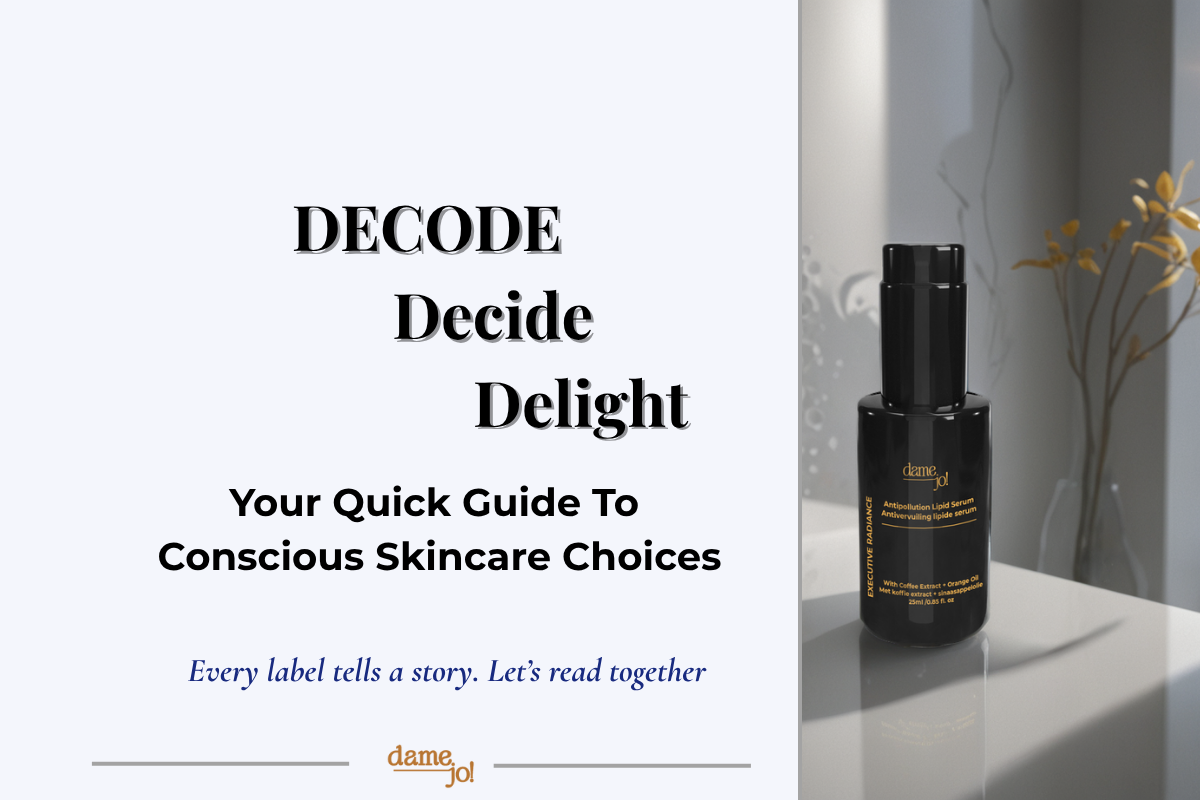Article: How to Read Skincare Labels Like a Formulator

How to Read Skincare Labels Like a Formulator
How to Read Skincare Labels Like a Formulator
When was the last time you read a skincare label and felt informed rather than overwhelmed?
You do not need a lab coat—just a quiet moment, a curious eye, and the right guide. At Dame Jo!, we believe every ingredient tells a story—and every woman deserves to understand it.
In this first chapter of Skincare Decoded, we walk through the anatomy of your bottle: INCI names, base carriers, and active ingredients. No overwhelm. Just clarity, intention, and soulful science.
First, What Is INCI?
Before we explore skincare ingredients, let us start with the language printed on every skincare label. Most skincare labels follow INCI—the International Nomenclature of Cosmetic Ingredients. It blends Latin, English, and scientific terms into a globally consistent language.
INCI names often sound scientific or unfamiliar (think Simmondsia Chinensis instead of “jojoba oil”), but once you learn to read them, you unlock the full story of what is inside your bottle—from functional actives to soulful textures.
How do you decode it? Start with —a free, science-backed tool that breaks down ingredient lists in plain language. Or simply search the INCI name online to find its common name and function.
Base Carriers: The Foundation of Your Formula
The first few ingredients listed—often water, hydrosols, oils, or glycols—are base carriers. These shape how the product feels, absorbs, and delivers actives to your skin. In water-based emulsions, they hydrate and vanish quickly. In oil-based formulas, they nourish and carry actives deeper into the skin’s lipid layers.
They also influence stability, shelf life, and performance. These are not fillers—they are strategic, functional, and chosen with care.
Carrier Oils That Act Like Active Ingredients
Some oils do more than moisturise—they deliver targeted, measurable effects that influence skin function, much like active ingredients. Rich in phytochemicals, they offer antioxidant protection, barrier repair, and anti-inflammatory benefits. These are full-spectrum skin allies.
Here are just a few high-performing oils that behave like actives:
-
Grapeseed Oil: Refines texture, tightens pores, defends against oxidative stress.
-
Blackberry Seed Oil: Brightens, calms, and reinforces the skin’s barrier.
-
Watermelon Seed Oil: Balances sebum, reduces puffiness, supports circulation.
-
Jojoba Oil: Balances sebum, calms inflammation, strengthens the skin’s barrier.
These oils blur the line between base and active ingredients—chosen not just for texture, but for transformation.
Active Ingredients: Precision Over Hype
Active ingredients target specific concerns—brightening, calming, clarifying. Their placement on the label reflects dosage, not importance. Do not be surprised if Bakuchiol or Magnolia Extract appear lower down—they are potent at low concentrations, and their position reflects dosage, not impact.
In the EU, actives are tightly regulated. More is not always better. Balance is everything.
“Formulating with purpose means using just what your skin needs to thrive. No overload. No underuse. Just harmony.”
From Mystery to Map
Once you learn to translate INCI, the label becomes a quiet conversation. You begin to understand the product’s true purpose. It shifts from mystery to map—guiding you toward what truly serves your skin.
Start with curiosity. Ask: What does this ingredient do? Why is it here? With the help of tools like and a simple online search, within seconds, you will know whether it belongs in your routine.
Read With Intention
Next time you pick up a bottle, do not just scan for buzzwords. Read with intention. Your skin deserves thoughtful formulas—and understanding the label is the first step.
In the next chapter, we shall decode the quiet heroes of your formula—functional ingredients, aromaceuticals, and preservation systems.
Soulful skincare begins with knowing what is inside your bottle—and why it is there.
